Sharrow Props Made For Heavy Outboard Cruisers
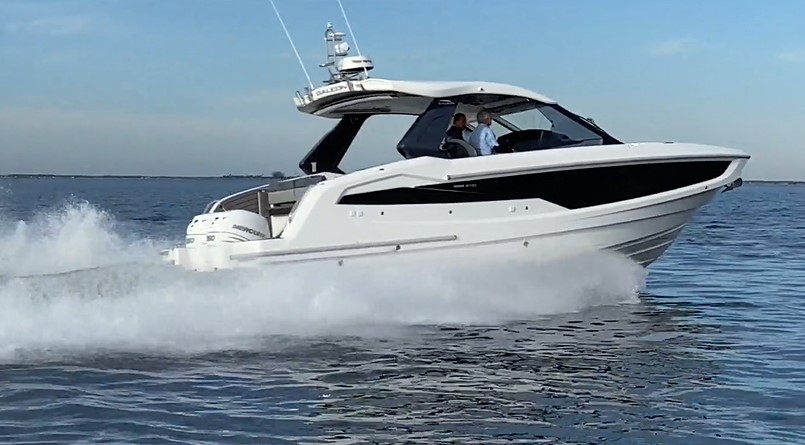
Marine Max is sole distributor of Galeon yachts in the Western Hemisphere. As such, it has a strong vested interest in getting the best performance out of the engines on each of its boats. With the Galeon 325 GTO, Marine Max had what could ultimately be one of the biggest sellers in class because it checked nearly all of the boxes people wanted —
*Day boat with fold-down platform
*Coupe express cruiser
*Large, deep cockpit for entertaining
*Rugged construction for offshore work
*21-degree transom deadrise for a softer ride
*Two sleeping cabins below w/private stand-up head
*Twin engine outboard power
*Affordable price
But, there was one box not checked. Because this boat is essentially an express cruiser and built for rugged offshore work with a 21-degree deadrise at the transom, she is by her nature relatively heavy, with a displacement of nearly 15,700 lbs. (7,272 kgs.) fully laden with gear, full fuel and passengers. The powers that be decided to investigate Sharrow props and following are the results of Sharrow’s demo sea trials.
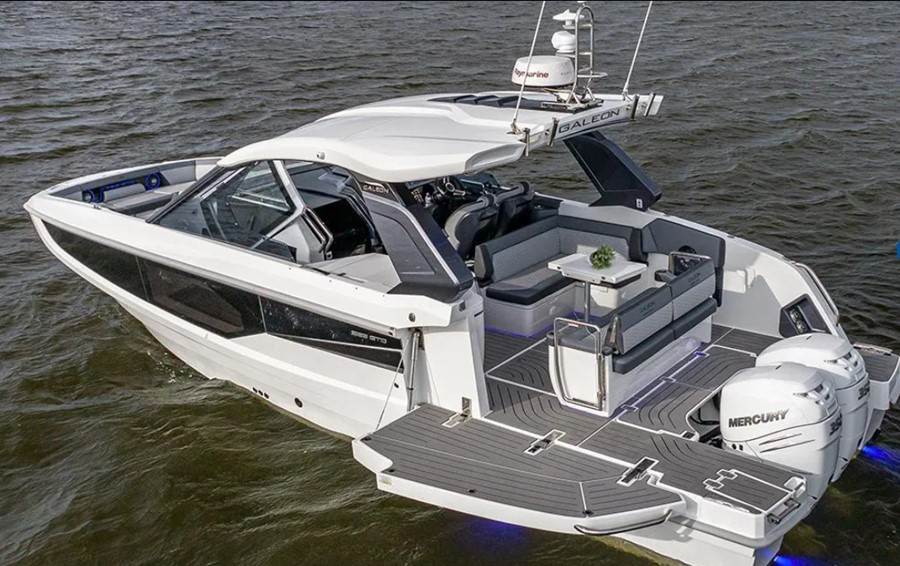
Sharrow Marine techs recently tested the new Galeon 325 GTO powered by twin Mercury inline 6 cylinder 2.6 L supercharged 400-hp outboard engines. The props used were the standard 14.6” x 15” wheels, that normally come with engines. Then, the techs tested the same boat, at the same weight, with Sharrow Marine 15.5” x 13.9” True Advance™ props. Sharrow reports that the boat weighed about 15,700 ils. (7,136 kgs) for both tests. Marine Max’s Galeon personnel were on hand for the testing, as well as Sharrow techs.
Mission: Getting on Plane Faster
Most boat builders shoot for getting a boat in this class with twin outboards, on plane at 3500-4000 RPM. Some do, but many boats this size and weight can’t get on plane 4000 RPM with twins.
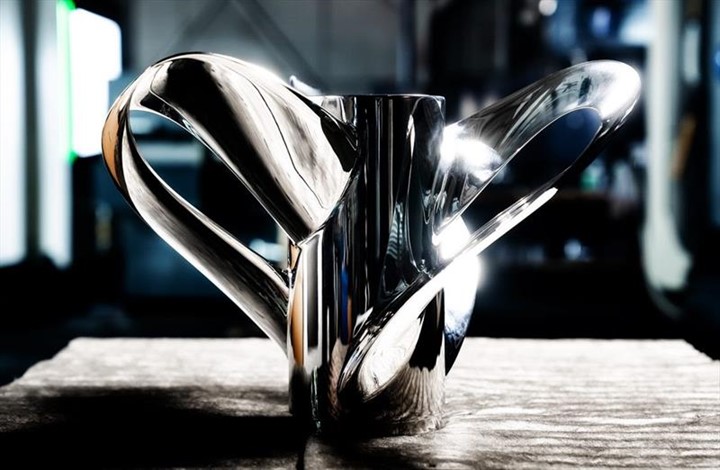
In Sharrow Marine’s test, as can be seen in the chart below, the vessel did not get on plane until about 4600 RPM with the conventional 14.6” x 15” props. When the boat was tested later with the same fuel and number of people aboard with the Sharrow props, the 325 GTO got on plane at about 3800 RPM – 700 to 800 RPM less than with the conventional props, according to a detailed report from Sharrow Marine.
This was a huge accomplishment and allows the Galeon 325 GTO to get on plane right in the middle of the 3500-4000 RPM range that most builders shoot for— and she does it with twin outboards, not triples. This is a key performance detail that sets the 325 GTO up for wide popularity.

The Cruising Sweet Spot
Perhaps equally as important, at 4000 RPM the Galeon was solidly on plane and cruising at 23.6 MPH, while the boat was still struggling to get over its bow wave at that RPM with conventional wheels. At 4500 RPM with Sharrow props the 325 GTO hit its stride going 28.8 mph — compared with the conventionally-propped boat not yet solidly on plane.
Comparing Fuel Consumption


The most economical fuel consumption provided by both props was the Sharrow props at 28.2 mph — where the boat got .92 miles per gallon, 64% more than the standard props. Given the weight of the boat and the fact that power was provided by twin 400-hp engines, getting nearly 1 mile per gallon was an achievement.
Time to 30 MPH
The Sharrow techs explained that they did not take “time-to-plane” readings because of the imprecision of knowing precisely when a boat is truly on plane. Is it when the bow begins to drop, when a rooster tail is formed in the wake, or when the trailing edge of the bottom can be seen? Some engine makers concur with this observation, which is why they don’t report time to plane.
Instead of time to plane, the Sharrow techs measured the time to get to 30 mph. When propped with conventional props, it took the 325 GTO 16.53 seconds to hit 30, they reported. When equipped with Sharrow props, the Galeon reached 30 mph in 10.76 seconds – nearly 6 seconds sooner.
What Does “True Advance ™” Mean?
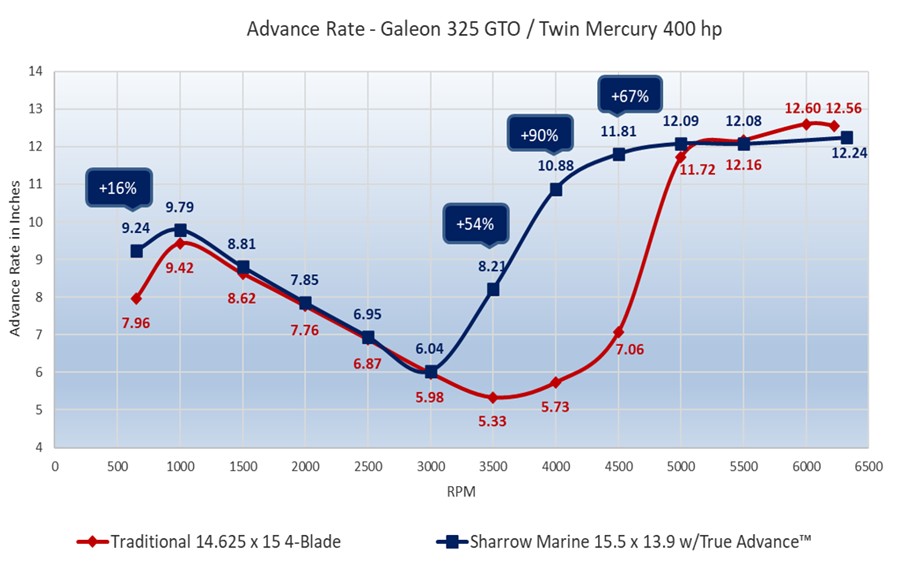
The secret of the Sharrow prop’s success is explained in the chart above. In the mid-RPM range, the Sharrow prop simply advances more than conventional props — all of them, not just the ones seen here. In the chart above, the most dramatic difference is at 4000 RPM where the Sharrow prop is advancing, with every 360-degree revolution, 10.88.”
The conventional prop at 4000 RPM, is advancing only 5.73” — just over half as much distance, so the Sharrow prop is advancing 90% farther with each revolution. In the world of conventional props, this kind of dramatic improvement is unheard of.
“True Advance™” is Sharrow prop’s signature statement because, as can be seen above, at its best, it is advancing 12.24” for every revolution of its 13.9” pitch prop. That means it is advancing 88% of its stated pitch. At 4000 RPM it is advancing at a rate of 78.3% of its stated pitch, something some conventional props can’t even achieve at full throttle. Thus — “True Advance.™”
Our Observations
Here are our take-aways from this comparison test aboard the Galeon 325 GTO—
- Large, heavy cruisers with outboard power can have their performance enhanced on the order of 1000 RPM with Sharrow props in the cruising range between 3500 and 5500 RPM.
- Getting on plane fast is important. By getting on plane quickly the bow comes down faster and the boat is under full control sooner, making the boat safer to operate.
- Lower Planning RPM. Because the 325 GTO gets on plane at a lower RPM than with conventional props, owners have a far wider range of RPM settings and fuel consumption rates from which to choose when operating the boat.
- Given the cost of the Galeon 325 GTO, and the cost of a pair of Sharrow props ($5,000 each) — 1.7% of the cost of the vessel — Sharrow props, it seems to us, are well worth the money given the increased performance. In larger, more expensive boats, a set of Sharrow props might cost as little as 1%, or less, of the overall boat’s cost.
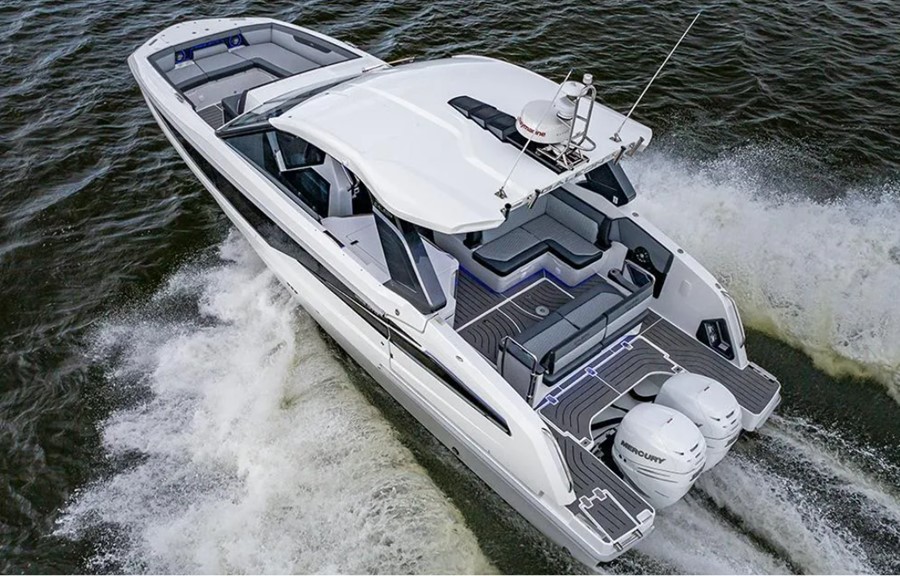
To see BoatTEST's coverage of all Sharrow props tested, click here...
[Sharrow Website] [Sharrow Marine Order Form] [BoatTEST Videos]